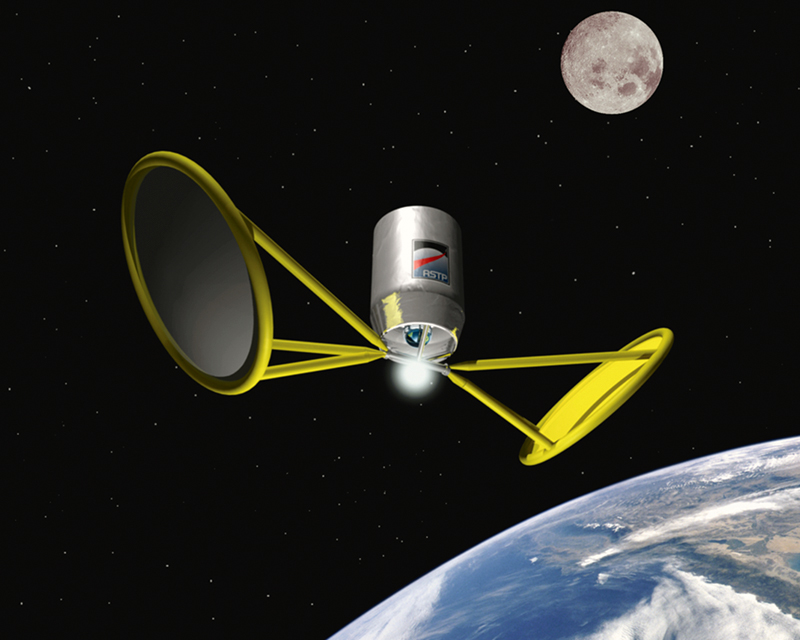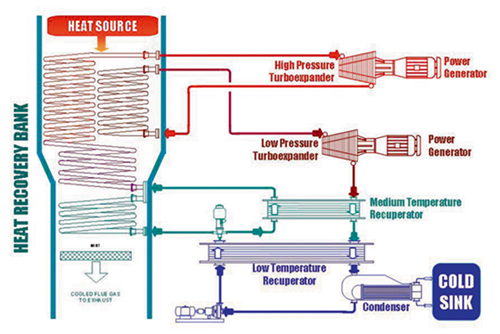
Making the Most of Waste Energy
Originating Technology/NASA Contribution
The Thermo-Mechanical Systems Branch at NASA’s Glenn Research Center is responsible for planning and conducting research efforts to advance thermal systems for space, aerospace, and non-aerospace applications. Technological areas pertain to solar and thermal energy conversion. For example, thermo-mechanical systems researchers work with gas (Stirling) and liquid/vapor (Rankine) systems that convert thermal energy to electrical power, as well as solar dynamic power systems that concentrate sunlight to electrical power.
The branch’s development of new solar and thermal energy technologies is propelling NASA’s missions deep into unfamiliar territories of space. Solar dynamic power systems are actively improving the health of orbiting satellites, giving them longer life and a stronger radiation tolerance, thus, creating less need for on-orbit maintenance. For future missions, NASA may probe even deeper into the mysterious cosmos, with the adoption of highly efficient thermal energy converters that have the potential to serve as the source of onboard electrical power for satellites and spacecraft. Research indicates that these thermal converters can deliver up to 5 times as much power as radioisotope thermoelectric generators in use today, for the same amount of radioisotope.
On Earth, energy-converting technologies associated with NASA’s Thermo-Mechanical Systems Branch are being used to recover and transform low-temperature waste heat into usable electric power, with a helping hand from NASA.
Partnership
In 2003, Mount Prospect, Illinois-based Unitel Technologies, Inc., approached NASA with an idea for an advanced energy recovery cycle that it believed could cost-efficiently convert low-level thermal energy sources from previously untapped resources—such as hot gas exhausted from power plants—into usable electric power.
According to Unitel Technologies, each and every day, all around the world, an incalculable amount of energy is wasted and literally blown into the atmosphere through power plant smokestacks and industrial and commercial heating systems. Billions of energy units are additionally carried away by the cooling water and air that are used in many of the related processes, the company added.
“Power plants, be they stationary or vehicle, are typically not very good at squeezing the last few BTUs (British thermal units—used to measure heat created by the burning of any material) out of their fuel source,” noted Serge Randhava, president of Unitel Technologies. “Much of this lost potential is simply blown up the stack or out of exhaust pipes, in the form of low-level waste heat. The volumes of this thermal energy are unfathomably large, but the temperatures are low, and conversion of low-level heat sources into usable electric power can be difficult,” he added.
The company’s proposal to NASA aimed to address this issue. As it turned out, however, the Space Agency already possessed some expertise in this area. Researchers from Glenn’s Thermo-Mechanical Systems Branch developed thermodynamic-analysis software to aid in the recovery of the exhaust heat, or waste heat, from the Rankine-cycle engines of M1 Abrams military battle tanks. The two parties agreed to enter into a partnership in which their knowledge would be shared to advance thermal energy recovery efforts throughout industry.
Unitel Technologies received a NASA grant to design a prototype waste heat recovery system called NEOGEN. The goal was to achieve a nominal energy-savings gain of approximately 20 percent over the recuperated binary Rankine cycle. The work was carried out with assistance from the Glenn researchers and engineers from Creare, Inc., who aided in the development of the thermodynamic-analysis software. Moreover, an award from the NASA Illinois Commercialization Center supported NASA’s thermodynamic-efficiency analyses of NEOGEN.
With regard to the prototype’s design, the idea was to create a system that could use a unique absorption cycle to tap into waste heat streams of 125 °C (257 °F) to 400 °C (752 °F). Using the thermodynamic-analysis software, Glenn researchers modeled the cycle efficiencies, optimized the heat exchanger design, and provided operating cost data. In addition, NEOGEN performance was benchmarked against related systems that NASA worked with in the past.
The results of this cooperative research effort were successful. The three parties took a concept for a new heat recovery cycle, with a unique and flexible working solution, all the way to demonstration-ready design.
“Working with NASA let us dramatically short-circuit our development program,” said Randhava. “We were able to go directly from concept to prototype design phase without the need for endless bench and pilot scale experiments.”
On top of the time savings, the partnership with Glenn saved Unitel Technologies over $250,000 in developmental costs.
Product Outcome
While a heat recovery system able to operate in the lower spectrum of waste temperatures opens up an enormous number of applications for exploitation, Unitel, with continued guidance and resource-support from NASA, decided to tiptoe into commercialization with a single focus on marine power plants, where everyday, just one single large ship can generate billions of BTUs in the form of low-level waste heat.
According to the company, marine power plants have a few unique characteristics that make them well-suited for waste heat recovery, and a few which make them a challenge. One advantage is that there are vast, cold sinks sloshing beneath every marine power plant outside of dry dock. Unitel, NASA, and Creare designed the NEOGEN system based on a 27 °C (81 °F) cold sink—equivalent to oceanic temperatures. On the challenging side, there is limited space for a recovery unit to operate within the power plant of a marine vessel, plus, there are many safety considerations that come with operating such machinery on a ship.
“If the NEOGEN system can help us harvest even a modest fraction of this energy stream, we can save a lot of fuel and help our environment at the same time,” claimed Randhava.
Beyond the initial marine power plant applications, the company plans to use its system to recover energy from other industrial plants, as well as commercial plants, electric utility facilities, diesel engines, and gas turbines. The company is looking to gain a foothold in these areas that it said were largely disregarded until about 4 years ago, when the price of crude oil started its upward climb.
“Most of the waste heat recovery strategies in use today are directed at high-temperature streams, usually over 400 °C (752 °F). The low-temperature spectrum has been ignored because the driving economic pressures were simply not there,” said Randhava. “The decision has now become highly significant, given the fact that the price of crude oil is more than $60 per barrel. Every BTU of energy that can be saved means money in the bank, more so now than ever.”

This system schematic was developed by Unitel Technologies, Inc., Creare, Inc., and Glenn Research Center. The ensuing waste heat recovery unit features a twin-turbo generator and a twin-recuperator configuration that give it great flexibility in heat-source harvesting.

Harnessing the Sun’s energy through solar thermal propulsion could propel vehicles through space by significantly reducing weight, complexity, and cost while boosting performance over current conventional upper stages. Pictured is an artist’s conception of space flight using solar thermal propulsion.













